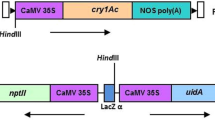Abstract
To enhance the level of resistance to insects in tropical maize germplasm we have developed techniques to successfully transform elite tropical maize inbred based on the activity of specific cryI proteins against four major maize pests – corn earworm, fall armyworm, southwestern corn borer and sugarcane borer. Constructs containing cryIAb or cryIAc synthetic genes were used. To generate transgenic plants we have established methods for biolistic bombardment and the selection and regeneration of immature embryos and calli from the elite tropical lines CML72, CML216, CML323, CML327 and hybrids. Transgenic plants resistant to the herbicide BastaTM contained the bands for the cry, bar and gus genes as detected by Southern blot analyses. A simple leaf bioassay presented varying levels of resistance to Southwestern corn borer of transgenic tropical maize carrying the cryIAc gene. Analyses of the progenies confirmed the sexual transmission of the introduced genes and their stable expression.
Similar content being viewed by others
Author information
Authors and Affiliations
Additional information
Received: 25 September 1998 / Accepted: 27 October 1998
An Erratum for this article can be found at http://dx.doi.org/10.1007/s00122-012-1864-0
Rights and permissions
About this article
Cite this article
Bohorova, N., Zhang, W., Julstrum, P. et al. Production of transgenic tropical maize with cryIAb and cryIAc genes via microprojectile bombardment of immature embryos. Theor Appl Genet 99, 437–444 (1999). https://doi.org/10.1007/s001220051255
Issue Date:
DOI: https://doi.org/10.1007/s001220051255




